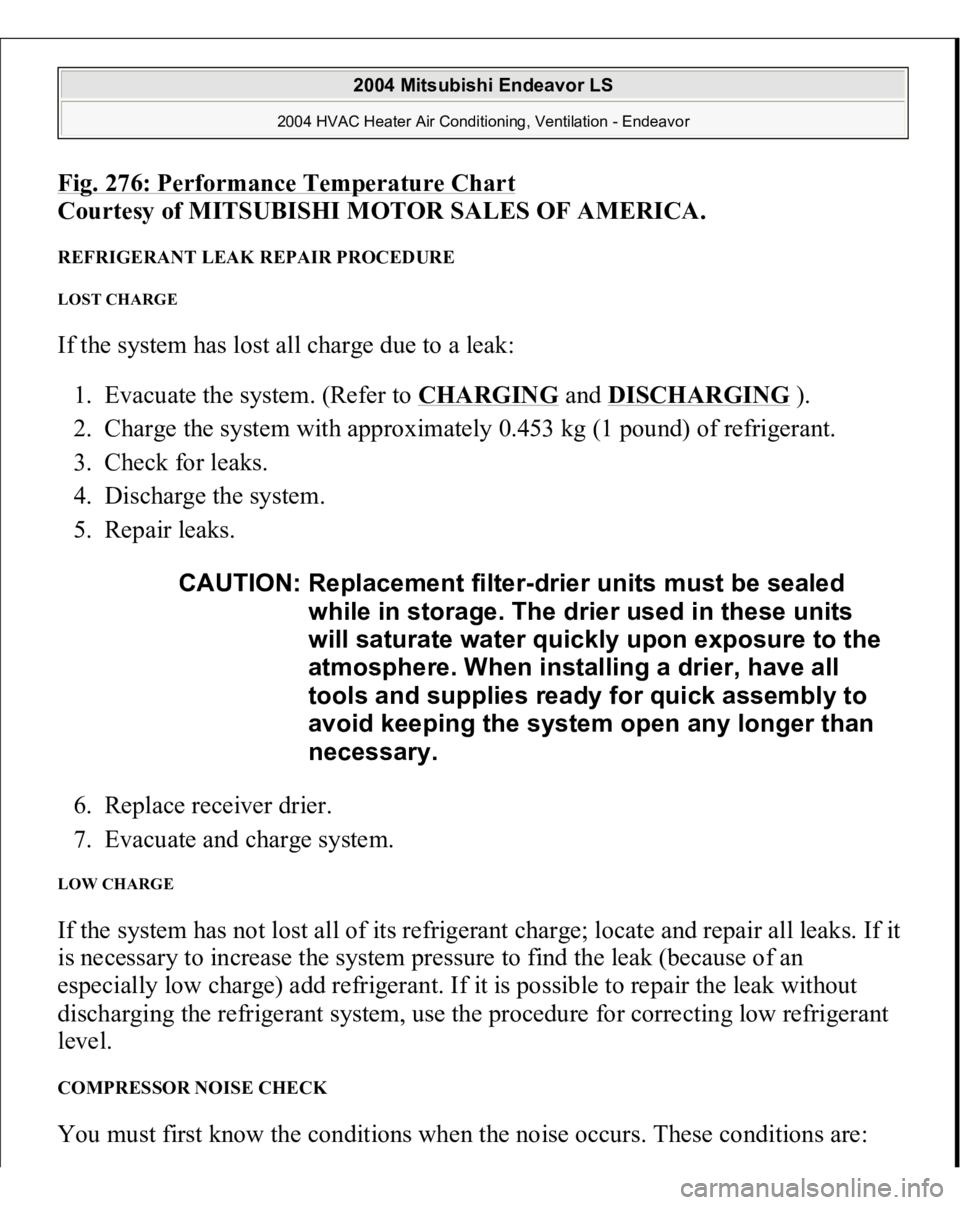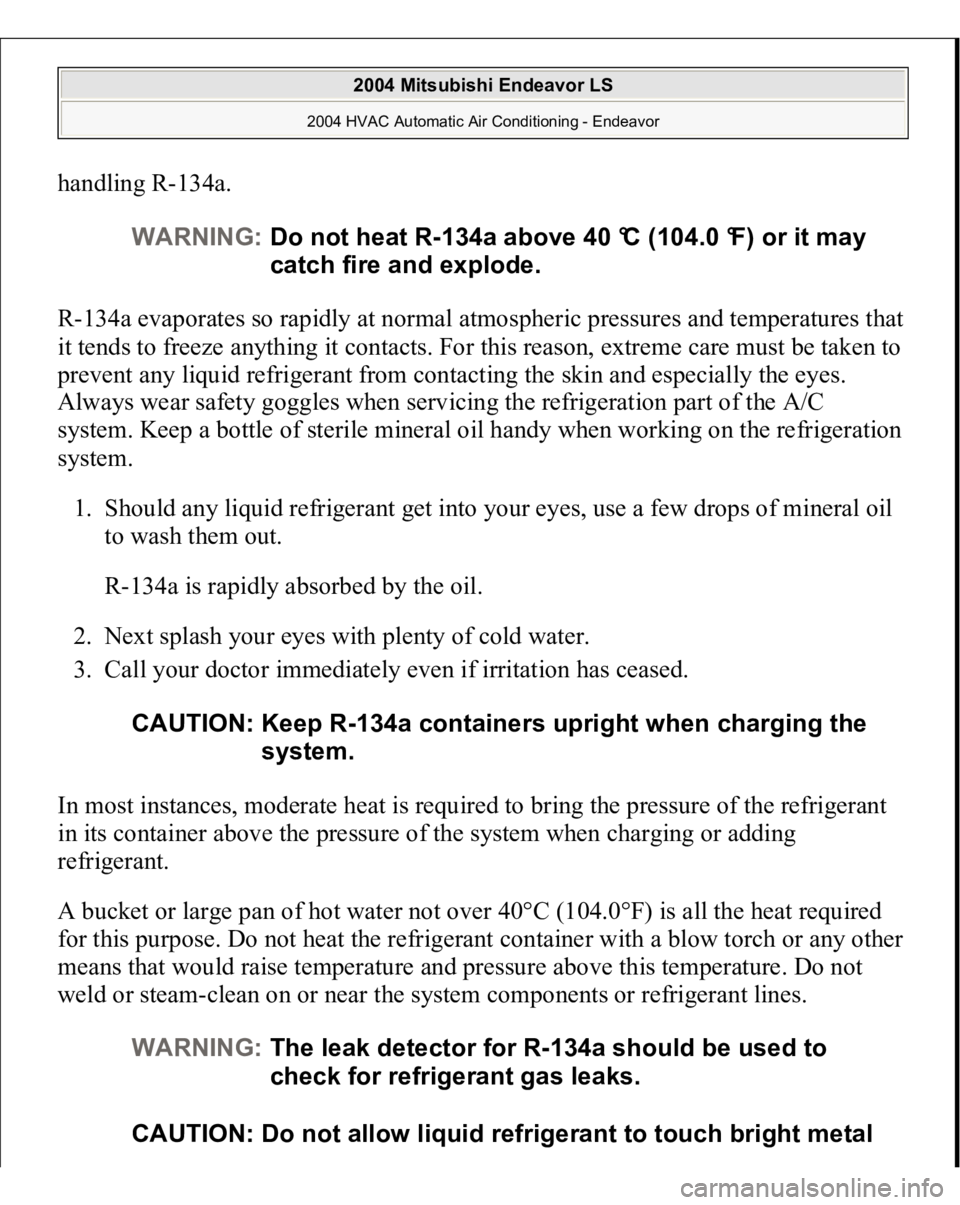Page 2272 of 3870
Fig. 198: Locating Connector C
-108
Courtesy of MITSUBISHI MOTOR SALES OF AMERICA.
2. Measure the resistance value between terminal 2 and ground.
The measured value should be 2 ohms or less.
Q: Does the measured resistance value correspond with this range?
YES:
Go to Step 15 .
NO:
Go to Ste
p 14.
2004 Mitsubishi Endeavor LS
2004 HVAC Heater Air Conditioning, Ventilation - Endeavor
Page 2283 of 3870
Fig. 206: Locating Connector C
-108
Courtesy of MITSUBISHI MOTOR SALES OF AMERICA.
2. Measure the resistance value between terminal 2 and ground.
The measured value should be 2 ohms or less.
Q: Does the measured resistance value correspond with this range?
YES:
Go to Step 4 .
NO:
Go to Ste
p 3.
2004 Mitsubishi Endeavor LS
2004 HVAC Heater Air Conditioning, Ventilation - Endeavor
Page 2327 of 3870
Fig. 238: Measuring Resistance Between Terminal 1 And GroundCourtesy of MITSUBISHI MOTOR SALES OF AMERICA.
Q: Does the measured resistance value correspond with this range?
YES:
Go to Step 16 .
NO:
Go to Step 15.
STEP 15. Check the wiring harness between defogger connector F-05
(terminal 1) and ground.
Q: Is the wiring harness between defogger connector F-05 (terminal 1) and
ground in good condition?
YES:
No action is necessar
y and testin
g is com
plete.
2004 Mitsubishi Endeavor LS
2004 HVAC Heater Air Conditioning, Ventilation - Endeavor
Page 2352 of 3870
Fig. 260: Measuring Resistance Between Terminal 27 And Ground
Courtesy of MITSUBISHI MOTOR SALES OF AMERICA.
Q: Does the measured resistance value correspond with this range?
YES:
Replace the A/C-ECU, and check that the air conditioning works
normally.
NO:
Go to Step 9.
STEP 9. Check the wiring harness between A/C-ECU connector C-17
(terminal 27) and the ground.
Q: Is the wiring harness between A/C-ECU connector C-17 (terminal 27)
and ground in good condition?
2004 Mitsubishi Endeavor LS
2004 HVAC Heater Air Conditioning, Ventilation - Endeavor
Page 2370 of 3870

Fig. 276: Performance Temperature Char
t
Courtesy of MITSUBISHI MOTOR SALES OF AMERICA.
REFRIGERANT LEAK REPAIR PROCEDURE LOST CHARGE If the system has lost all charge due to a leak:
1. Evacuate the system. (Refer to
CHARGING
and
DISCHARGING
).
2. Charge the system with approximately 0.453 kg (1 pound) of refrigerant.
3. Check for leaks.
4. Discharge the system.
5. Repair leaks.
6. Replace receiver drier.
7. Evacuate and charge system.
LOW CHARGE If the system has not lost all of its refrigerant charge; locate and repair all leaks. If it
is necessary to increase the system pressure to find the leak (because of an
especially low charge) add refrigerant. If it is possible to repair the leak without
discharging the refrigerant system, use the procedure for correcting low refrigerant
level. COMPRESSOR NOISE CHECK You must first know the conditions when the noise occurs. These conditions are:
CAUTION: Replacement filter-drier units must be sealed
while in storage. The drier used in these units
will saturate water quickly upon exposure to the
atmosphere. When installing a drier, have all
tools and supplies ready for quick assembly to
avoid keeping the system open any longer than
necessary.
2004 Mitsubishi Endeavor LS
2004 HVAC Heater Air Conditioning, Ventilation - Endeavor
Page 2420 of 3870

handling R-134a.
R-134a evaporates so rapidly at normal atmospheric pressures and temperatures that
it tends to freeze anything it contacts. For this reason, extreme care must be taken to
prevent any liquid refrigerant from contacting the skin and especially the eyes.
Always wear safety goggles when servicing the refrigeration part of the A/C
system. Keep a bottle of sterile mineral oil handy when working on the refrigeration
system.
1. Should any liquid refrigerant get into your eyes, use a few drops of mineral oil
to wash them out.
R-134a is rapidly absorbed by the oil.
2. Next splash your eyes with plenty of cold water.
3. Call your doctor immediately even if irritation has ceased.
In most instances, moderate heat is required to bring the pressure of the refrigerant
in its container above the pressure of the system when charging or adding
refrigerant.
A bucket or large pan of hot water not over 40°C (104.0°F) is all the heat required
for this purpose. Do not heat the refrigerant container with a blow torch or any other
means that would raise temperature and pressure above this temperature. Do not
weld or steam-clean on or near the system components or refrigerant lines.
WARNING:Do not heat R-134a above 40 °C (104.0 °F) or it may
catch fire and explode.
CAUTION: Keep R-134a containers upright when charging the
system.
WARNING:The leak detector for R-134a should be used to
check for refrigerant gas leaks.
CAUTION: Do not allow liquid refrigerant to touch bright metal
2004 Mitsubishi Endeavor LS
2004 HVAC Automatic Air Conditioning - Endeavor
Page 2477 of 3870
Fig. 43: Measuring Resistance Value Between Terminal 2 And Ground
Courtesy of MITSUBISHI MOTOR SALES OF AMERICA.
Q: Does the measured resistance value correspond with this range?
YES:
Go to Step 12 .
NO:
Go to Step 11.
STEP 11. Check the wiring harness between rear blower relay connector
C-209 (terminal 2) and the ground.
2004 Mitsubishi Endeavor LS
2004 HVAC Automatic Air Conditioning - Endeavor
Page 2489 of 3870
Fig. 54: Measuring Resistance Value Between Terminal 3 And Ground
Courtesy of MITSUBISHI MOTOR SALES OF AMERICA.
Q: Does the measured resistance value correspond with this range?
YES:
Go to Step 18 .
NO:
Go to Step 17.
STEP 17. Check the wiring harness between floor console rear A/C switch
assembly connector C-19 (terminal 3) and ground.
Q: Is the wiring harness between floor console rear A/C switch assembly
2004 Mitsubishi Endeavor LS
2004 HVAC Automatic Air Conditioning - Endeavor